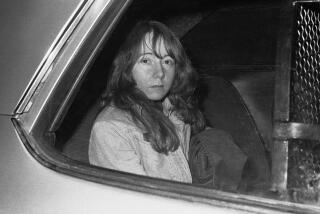25 Years After King’s Death, Doubts Survive : Assassination: James Earl Ray pleaded guilty to murdering the civil rights leader, but has denied his guilt ever since. Members of a House panel that examined the probe say they fear they were misled and ask that it be reopened.
- Share via
In 1978, Walter Fauntroy spoke proudly of the congressional inquiry he helped oversee into the assassination of Dr. Martin Luther King Jr., with its dozens of hearings, scores of witnesses and 487 trips by investigators to track leads in five countries.
The far-ranging effort by the House Select Committee on Assassinations was well worth it, Fauntroy said then. “The American people want to know that their government is telling them the whole truth,” he said.
Today, however, he doubts that the whole truth came out.
Fauntroy has joined historians and researchers in calling for a new and independent investigation of what happened in Memphis 25 years ago today.
“I’m not out to prosecute anyone,” said the former chairman of the subcommittee examining King’s death. “I’m looking for the truth.”
Fauntroy’s concern grew not from any newly discovered “smoking gun” evidence, but from what he called a troubling “plethora of new information”--notably former FBI Director J. Edgar Hoover’s hatred and harassment of King and reported U.S. Army spying on the civil rights movement.
“I feel that a very determined effort was made by the FBI to--I want to choose my words very carefully--to prevent our committee from conducting a thorough investigation of the assassination,” he said. “Not the FBI--operatives in the FBI.”
Thousands of pages of documents that the assassinations committee received from the FBI were partially blacked out, Fauntroy said, obscuring information he now believes might hold clues.
“There’s been just too much secrecy,” said Bob Edgar, another former assassinations committee member who supports a renewed investigation.
For nearly a quarter-century, despite James Earl Ray’s imprisonment for King’s murder, researchers have said the same thing. Still, the King case often was lost in the glare trained on President John F. Kennedy’s assassination, which the committee also investigated.
Now, the spotlight may be turning back to Memphis.
Airing tonight is an HBO cable network special in which Ray, who pleaded guilty as King’s killer and ever since has sought a trial to disprove it, finally gets his day in “court.” A mock trial on the murder charge was filmed in a Memphis courtroom, using the 1969 prosecutor’s file that Ray sued to open.
From the beginning, some have suspected that Ray was at most a bit player in a conspiracy.
Arthur Hanes Sr. and Jr., his first lawyers, said time has not erased their many reasons for doubting Ray’s guilt--from his own statements to inconclusive ballistics evidence. “The cumulative effect of all of it is just compelling to us,” said Hanes Jr., now an Alabama judge.
Some investigators insist that government files sealed until 2029, to protect confidential sources and individuals’ privacy, could help point to people with answers.
“Not only are there unpursued leads . . . but there are definitely clues in there for expanding the database,” said Philip Melanson, a scholar on political violence who has called for unsealing the files and urged appointment of a special prosecutor.
But Harold Sawyer, another former committee member, noted that no criminal investigation answers every question.
“There are always loose ends,” said Sawyer, who as a lawyer defended and prosecuted murder cases. “It never works out like it does on TV.”
Ultimately, he concluded that Ray was the triggerman, he said, partly because Ray did not take up Sawyer’s offer to intercede to get his sentence reduced if he would provide evidence leading to any other conspirators.
The circumstantial case against Ray seems overwhelming.
No one disputes that Ray, a petty criminal with numerous arrests for nonviolent property crimes, was in Memphis when King was killed. His fingerprint was found on a rifle at the scene.
Ray acknowledges that he rented a room in the flophouse from which authorities say the single 30.06 rifle shot was fired, and that he drove a white Mustang like one described as leaving the scene.
But he maintains that he was set up by a man known to him only as “Raoul,” who gave Ray instructions to buy the car and weapon--and thousands of dollars to pay for them--and directed his movements across the United States and in Canada and Mexico in the months leading up to the assassination.
Ray denies that he fired the shot. He pleaded guilty, he contends, only because of the duress of eight months of solitary confinement, much of the time under 24-hour lights. “A midnight sunstroke,” he called it.
His biggest mistake, Ray has said, was firing the Haneses as his lawyers and retaining the late Percy Foreman, who negotiated his plea and 99-year sentence.
The younger Hanes said he and his father were preparing to go to trial, and were confident.
They planned to undermine the testimony of the state’s star witness, a fellow resident of the flophouse who claimed to have seen a fleeing man resembling Ray. The witness’s common-law wife would testify that he had been drunk at the time and that the fleeing man was shorter than Ray and much lighter.
The defense also would have pointed to items found in Ray’s abandoned Mustang, including clothing that would fit only a lighter man, and cigarette butts, though Ray did not smoke. Two white Mustangs were parked outside the flophouse, according to witnesses.
In repeated conversations with Ray, the Haneses could not come up with a motive for him to kill King on his own. Some researchers said he wanted money or fame and expected lenient treatment in Southern courts for the racial crime. But, noted Hanes Sr., “I never heard him make a racial slur.”
Ray’s current lawyer, William Pepper, sees him as the victim of a justice system with different sets of standards and procedures for criminal cases and those “that may be referred to as political.”
Two weeks after his plea, Ray filed a handwritten request for a trial, but the judge died while considering it. Pepper said Tennessee law was clear: In such circumstances, a new trial automatically is granted. But Ray’s request was denied, while another inmate’s to the same judge was approved, Pepper said.
Investigators never have determined who Ray’s “Raoul” was, if he existed at all, or whether others might have conspired with him.
In its 13-volume report, the House assassinations committee concluded that Ray committed the crime “as a result of a conspiracy,” and said those likely involved were a cabal of St. Louis-based racists.
The Justice Department in 1988 said it had checked leads and found “no persuasive evidence” of a conspiracy.
“No further investigation appears to be warranted,” the department reported to the House Judiciary Committee, “. . . unless new information which is sufficient to support additional investigative activity becomes available.”
Such information might be found in the approximately 360 boxes of sealed assassinations committee files, say researchers such as Melanson, a professor of political science at Southeastern Massachusetts University.
Among those documents, he noted, may be one prepared by Canadian authorities concerning Ray’s associations in Montreal during the summer before King was killed. It was there that Ray claims he first met Raoul.
Harold Weisberg, another author and investigator, said he would like to see the special case index, a manifest of evidence and interviewees, that he believes the FBI prepared, as well as the full list of witnesses before the committee.
Committee files pertaining to the killing of Kennedy were ordered released by Congress last year, but the King portion was not included.
“They appear to be afraid of it,” said James Lesar, a lawyer who heads the Assassination Archives and Research Center in Washington and who testified in support of freeing the King files. “I’m increasingly conscious of how the passage of time erodes the ability to get at the truth.”
Several former members of the House panel now believe the closed files should be open, with safeguards to protect confidential sources and privacy.
Some expressed disappointment that the committee’s work was not carried further--especially “those threads that were so promising,” said ex-member Floyd Fithian. “There was no pursuit.”
Committee colleague Samuel L. Devine agreed that the files should be opened, but said they contain no breakthrough evidence. Devine, a former FBI agent, said he was disturbed by what he called unfounded criticism of the agency’s role in the case.
“There was no evidence of any government involvement,” he said.
But Edgar, another former committee member, disagreed. “In the ‘60s, we lived in a public perception of democracy,” he said, “but the private reality was a police-state mentality on the part of some in the intelligence agencies.”
The Commercial Appeal of Memphis reported last month on decades-long Army intelligence surveillance of King, up to the day he was shot. The newspaper said it found no evidence of an Army role in King’s death; the Army refused to comment to the AP.
“At the time we wrapped up our investigation in 1978, I had no idea,” Fauntroy said of the supposed surveillance.
More to Read
Sign up for Essential California
The most important California stories and recommendations in your inbox every morning.
You may occasionally receive promotional content from the Los Angeles Times.










